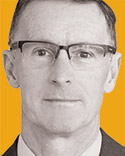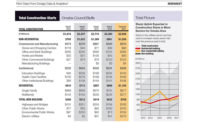
Matt Tondl
Senior Vice President, Nebraska/Iowa Area Manager
HDR
The AEC community is going strong in Omaha, Tondl says. “The pandemic and subsequent inflationary period have not slowed growth. The public and private sectors are strong. Data centers continue to grow, and significant projects continue in K-12 education and higher education,” he adds.
One multifaceted community project keeping crews busy is the Omaha Public Library’s construction of a new central library, which is slated to open in 2026.
HDR has provided architecture and various engineering and planning services for the $150-million project. The firm has also has been involved in design elements of another downtown library branch.
As the state’s largest city, Omaha also plays a key role in attracting the next generation of health care providers. The University of Nebraska Medical Center is contributing to that effort with a new hospital project on the horizon.
The university is making plans for a $2.19-billion academic medical center in Omaha.
“Having a new medical center fills a critical need in health care. The number of people needing quality care continues to increase, as do changes in technology,” Tondl says.
One key facility for quality health care in Omaha and a key project, o, primarily for HDR’s architecture team, has been Children’s Nebraska (formerly Children’s Hospital and Medical Center), which has undergone an expansion and renovation. The Hubbard Center addition doubled the capacity of the hospital, adding 100 beds. It is the only Nebraska facility exclusively for pediatric care. It serves more than 150,000 children a year.
Tondl says another giant project that is attracting not only attention but visitors to the urban core is a $300-million public/private investment in the downtown’s three major parks, which has resulted in a 72-acre park system that has become a hub of activity.
The revitalization project encompasses the Gene Leahy Mall, the Heartland of America Park and the Lewis & Clark Landing, which will now be referred to collectively as the RiverFront.
HDR served as the project’s design manager and engineer. More than 370 of its employees worked on the project over the past seven years.
“It meant navigating the complexities of permitting, flood walls, levees, endangered species and buried high-voltage transmission lines,” Tondl says.
He adds that HDR also completed design and planning services for the Kiewit Luminarium, an 82,000-sq-ft museum with more than 120 interactive exhibits in one of the combined parks.
Tondl says another prominent project is a 44-story headquarters for Mutual of Omaha that has broken ground downtown. At 677 ft tall, the building will feature approximately 800,000 sq ft of office, meeting, collaboration and amenity space.
“[Large] developments ... are important to reinvigorate commercial, retail and recreation in the region.”
—Matt Tondl, Senior Vice President, HDR
“Developments like these are important to reinvigorate commercial, retail and recreation in the region. But all of that can’t happen without accompanying infrastructure, like transportation,” he says.
HDR is taking a major role as project designer of an initial three-mile streetcar line in the city. It is being delivered through a CM/GC process, with Kiewit as the contractor. The streetcar will connect the heart of the urban core of downtown to the University of Nebraska Medical Center in midtown.
Beyond roadways and railways, Omaha is busy with construction associated with runways. Epply Airfield is in the initial stages of a major terminal project that will expand the airport to 30 gates from 20. HDR has been working with the Omaha Airport Authority on an expanded terminal entrance and a massive front drive canopy structure to protect passengers from rain and snow, he says.
With so much positive news, labor remains the biggest challenge.
“Competition for talent is fierce,” Tondl says.
On the recruitment front, HDR is partnering with a state-based community college that has an existing building information modeling (BIM) program.
“There is a significant industry need for BIM professionals, so we’re focusing on enhancing university curriculums to align skills with the AEC industry,” Tondl says. “We also added a BIM certificate for students, offering a base diploma on which an associate’s or bachelor’s degree could be added in the future.”
HDR has more than 12,000 employees worldwide.






Post a comment to this article
Report Abusive Comment